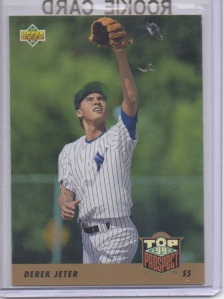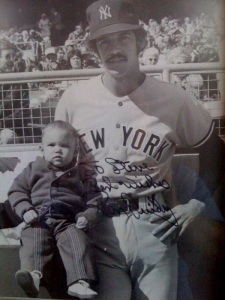As I pondered the Hall of Fame prospects of young members of the Kansas City Royals 2015 World Series champions, I wondered how rare it would be for a world champion to have no Hall of Famers.
While any young star faces long odds of reaching the Baseball Hall of Fame, quick research showed that a World Series winner without anyone making it to Cooperstown is also exceedingly rare.
I just went back to 1947 in answering my question, because, as I noted in an October post, Hall of Fame standards were much lower before baseball integrated.
So I will note year by year the starters and other important contributors of world champions who eventually became Hall of Famers. While I won’t speculate on whether players appeared bound for Cooperstown at the time (the point of yesterday’s post), I will note their ages at the time they won. If a player is in the Hall of Fame, but primarily for his play with another team, I will note that.
1947
Champion: New York Yankees. Hall of Famers: Yogi Berra, 22; Phil Rizzuto, 29; Joe DiMaggio, 32.
1948
Champion: Cleveland Indians. Hall of Famers: Larry Doby, 24; Bob Lemon, 27; Bob Feller, 29; Lou Boudreau, 30; Joe Gordon, 33.
1949-53
Champions: Yankees. Hall of Famers: Mickey Mantle, ’51-3, 19-21; Whitey Ford, ’50 and ’53, 21 and 24; Berra, all years, 24-28; Rizzuto, all years, 31-5; DiMaggio, ’49-’51, 34-6. Johnny Mize, a member of all five Yankee teams, was not a full-time starter most of these seasons. He joined the Yankees at age 36 and is in the Hall of Fame primarily for his slugging for the St. Louis Cardinals and New York Giants.
1954
Champion: New York Giants. Hall of Famers: Willie Mays, 23; Hoyt Wilhelm, 31; Monte Irvin, 35.
1955
Champion: Brooklyn Dodgers. Hall of Famers: Duke Snider, 28; Roy Campanella, 31; Jackie Robinson, 36; Pee Wee Reese, 36.
1956
Champion: Yankees. Hall of Famers: Mantle, 24; Ford, 27; Berra, 31. Rizzuto, 38, was a part-time player, as was Enos Slaughter, 40, elected to the Hall of Fame primarily as a St. Louis Cardinal.
1957
Champion: Milwaukee Braves. Hall of Famers: Hank Aaron, 23; Eddie Mathews, 25; Red Schoendienst, 34; Warren Spahn, 36.
1958
Champion: Yankees. Hall of Famers: Mantle, 26; Ford, 29; Berra, 33; Slaughter, 42.
1959
Champion: Los Angeles Dodgers. Hall of Famers: Don Drysdale, 22; Sandy Koufax, 23; Snider, 32.
1960
Champion: Pittsburgh Pirates. Hall of Famers: Bill Mazeroski, 23; Roberto Clemente, 25.
1961-2
Champions: Yankees. Hall of Famers: Mantle, 29-30; Ford, 32-3; Berra, 36-7.
1963
Champions: Dodgers. Hall of Famers: Drysdale, 26, and Koufax, 27.
1964
Champions: St. Louis Cardinals. Hall of Famers: Lou Brock, 25; Bob Gibson, 28.
1965
Champions: Dodgers. Hall of Famers: Drysdale, 28, and Koufax, 29.
1966
Champions: Baltimore Orioles. Hall of Famers: Jim Palmer, 20; Brooks Robinson, 29; Frank Robinson, 30, and Luis Aparicio, 32.
1967
Champions: St. Louis Cardinals. Hall of Famers: Steve Carlton, 22; Brock, 28; Orlando Cepeda, 29; Gibson, 31.
1968
Champion: Detroit Tigers. Hall of Famers: Al Kaline, 32; and Mathews (a part-time player in his final year at age 36). Since yesterday’s post was about Hall of Fame projections, I should note here that 24-year-old Denny McLain, who won 31 games that year and won the Cy Young and MVP awards, looked like a lock for Cooperstown, but didn’t make it.
1969
Champion: New York Mets. Hall of Famers: Nolan Ryan, 22, and Tom Seaver, 24.
1970
Champion: Orioles. Hall of Famers: Palmer, 24, and the Robinsons, 33 and 34.
1971
Champion: Pirates. Hall of Famers: Willie Stargell, 31; Mazeroski (playing part-time at 34); Clemente, 36.
1972-4
Champions: Oakland A’s. Hall of Famers: Rollie Fingers, 25-7; Catfish Hunter, 26-8; Reggie Jackson, 26-8. I don’t count Cepeda, who had just three at-bats for the ’72 A’s and didn’t play in the post-season.
1975-6
Champions: Cincinnati Reds. Johnny Bench, 27-8; Joe Morgan, 31-2; Tony Pérez, 33-4. Pete Rose, 34-5, would be in the Hall of Fame, but he accepted a lifetime ban from baseball for betting on games.
1977-8
Champions: Yankees. Hall of Famers: Jackson and Hunter, both 31-2; and Goose Gossage, 26 (’78 only).
1979
Champions: Pirates. Hall of Famers: Bert Blyleven, 28, and Stargell, 39. Dave Parker of this team probably deserves mention with Denny McLain as a player who appeared on his way to the Hall of Fame. Cocaine use sidetracked Parker’s career.
1980
Champions: Philadelphia Phillies. Hall of Famers: Mike Schmidt, 30; Carlton, 35. Rose, 39, was also on this team.
1981
Champions: Dodgers. No Hall of Famers yet. Steve Garvey probably has the best shot of making it someday.
1982
Champions: Cardinals. Hall of Famers: Ozzie Smith, 27, and Bruce Sutter, 29.
1983
Champions: Orioles. Hall of Famers: Cal Ripken Jr., 22; Eddie Murray, 27; Palmer, pitching part-time at age 37.
1984
Champion: Tigers. No Hall of Famers yet. Jack Morris, 29, probably has the best shot.
1985
Champion: Kansas City Royals. Hall of Famer: George Brett, 32.
1986
Champion: Mets. Hall of Famer: Gary Carter, 32. As noted in yesterday’s post, Dwight Gooden and Darryl Strawberry, 24, of this team appeared headed for the Hall of Fame before drug use stalled their careers.
1987
Champion: Minnesota Twins. Hall of Famer: Kirby Puckett, 27, and Blyleven, 36. Carlton, 42, pitched nine games for the Twins that year, but not in the post-season.
1988
Champion: Dodgers. Hall of Famer: Don Sutton, 43, was in his last year. He pitched only 16 games, none in the post-season. Of major contributors on this team, Orel Hershiser, 29, and Kirk Gibson, 31, may have the best shots at reaching Cooperstown someday.
1989
Champion: Oakland A’s. Hall of Famer: Rickey Henderson, 30, and Dennis Eckersley, 34. This is the first champion where performance-enhancing drugs are keeping a player out of the Hall of Fame (Mark McGwire, 25, for sure, possibly Jose Canseco, 24).
1990
Champion: Reds. Hall of Famer: Barry Larkin, 26.
1991
Champion: Twins. Hall of Famer: Puckett, 31.
1992-3
Champions: Toronto Blue Jays. Hall of Famers: Roberto Alomar, 24-5; Henderson, 34 (just on ’93 Jays); Paul Molitor, 36 (also just in ’93); Dave Winfield, 40 (only in ’92).
1995
Remember, baseball had no champion in ’94 because of a strike. Champions: Atlanta Braves. Hall of Famers: John Smoltz, 28; Greg Maddux and Tom Glavine, both 29. Chipper Jones, 24, appears to be a certain Hall of Famer, but retired in 2012, so he won’t be eligible for Hall of Fame consideration until the 2018 election.
1996
Champions: Yankees. Hall of Famer: Wade Boggs, 38. Derek Jeter, 22, and Mariano Rivera, 26, appear certain to reach Cooperstown when they become eligible for election: 2019 for Rivera and 2020 for Jeter. Andy Pettitte and Jorge Posada are less likely to make the Hall of Fame, and will be on the ballot in 2019 (Pettitte) and next year (Posada).
1997
Champion: Florida Marlins. No Hall of Famers. Gary Sheffield is another player whose Hall of Fame chances are hurt by PED use.
1998-2000
Champions: Yankees. Again, Jeter, 24-6, and Rivera, 28-30, are certain Hall of Famers. Roger Clemens, 36-7, pitched for the ’99-2000 Yankees, but suspicion of PED use is keeping him out of Cooperstown. Tim Raines, 38, a ’98 Yankee, got 55 percent of the baseball writers’ vote last year and almost certainly will make the Hall of Fame someday, but mostly for his play for the Montreal Expos.
2001
Champion: Arizona Diamondbacks. Hall of Famer: Randy Johnson. Curt Schilling will certainly join him. He got 39 percent of the writers’ vote last year, his third year on the ballot.
2002
Champion: Anaheim Angels. No Hall of Famers and no likely prospects.
2003
Champion: Florida Marlins. Miguel Cabrera, 20, is a Triple-Crown winner and two-time MVP. He’s still playing and only 32 years old but certain to make the Hall of Fame if he stays free of scandal. Iván Rodríguez would be a certain Hall of Famer if not for allegations that he used PEDs.
2004
Champion: Boston Red Sox. Hall of Famer: Pedro Martínez, and Schilling will follow. David Ortiz, who’s still playing, would be an automatic selection if not for his failed drug test. Manny Ramírez won’t be on the Hall of Fame ballot until 2017, but drug issues are likely to keep him out of the Hall of Fame, too.
2005
Champion: Chicago White Sox. Hall of Famer: Frank Thomas, a part-time DH at 37.
2006
Champion: Cardinals. No Hall of Famers yet, but Albert Pujols, a three-time MVP, is a lock if he can avoid scandal.
2007
Champion: Red Sox. This seems a good place to stop this exercise. No star of the ’07 Red Sox, or any subsequent champion, is already in the Hall of Fame, and most aren’t even eligible yet. I’ve already addressed Schilling, Ortiz and Ramírez. While I projected the Hall of Fame chances of the 2015 Royals, I’m not interested in doing that for the young stars of other recent teams.
What does this mean?
Obviously, the numbers or Hall of Famers on some of these teams, especially the more recent ones, will grow, as Morris, Raines, Schilling and others eventually get elected.
But already the vast world-champion teams have multiple Hall of Famers. In a 60-year stretch, only five teams don’t have Hall of Famers yet. From 1947 to 1980, the 1960 Pirates and ’68 Tigers were the only World Series champions without at least two Hall of Famers elected by the Baseball Writers Association of America.
All of the champions with no Hall of Famers or even just one played since 1980, so many of their best players aren’t even eligible for Hall of Fame consideration yet (or are being kept out of Cooperstown because of drug suspicions). Few of the contenders who aren’t automatic Hall of Famers have had second chances yet through the Expansion Era Committee.
As I noted in yesterday’s post, I expect at least two players from the 2015 Royals to join the Hall of Fame. If I’m wrong, they will be one of few exceptions among World Series champions.
Source note: Players’ ages are taken from the Baseball-Reference.com team rosters for the championship years.












